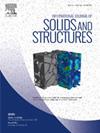热电材料与表面微波浪形刚性固体的粘接问题
IF 3.4
3区 工程技术
Q1 MECHANICS
International Journal of Solids and Structures
Pub Date : 2025-03-22
DOI:10.1016/j.ijsolstr.2025.113351
引用次数: 0
摘要
热电效应是由温差引起的电效应以及由电流引起的可逆热效应的总称,通常包括塞贝克效应、珀尔帖效应和汤姆逊效应。基于热电效应的热电器件越来越多地应用于温度测量和热电发电等实际工程中。周期性波状接触行为对热电器件的长期稳定性和能量转换效率的提高至关重要。本文采用积分方程法研究了热电半平面二维周期Maugis-Dugdale (MD)粘附接触行为。将接触问题转化为具有Hilbert核的奇异积分方程(SIE),其中黏聚区大小成为关键的未知参数。通过理论分析和数值计算,分析了经典Tabor参数和光滑槽面时槽面表面能与弹性应变能之比这两个无量纲参数下法向载荷、接触区和粘附区之间的关系,并讨论了它们在加载和卸载过程中的曲线分布。结果表明,表面越粗糙,由于黏附滞后造成的能量损失越大。随着总电流和能量流的增加,达到相同触点半宽所需的正常负载也会增加。这使我们能够通过改变热电负载来调整表面接触行为,从而改变接触面上的应力分布。本文章由计算机程序翻译,如有差异,请以英文原文为准。
Adhesive contact problem between thermoelectric material and rigid solid with slightly wavy surface
The thermoelectric effect is a general term for the electrical effects that arise from a temperature difference, as well as the reversible thermal effects induced by electric current, commonly including the Seebeck effect, Peltier effect, and Thomson effect. Thermoelectric devices based on the advantageous thermoelectric effect are increasing used in practical engineering, such as the temperature measurement and thermoelectric power generation. The periodic wavy contact behavior is crucial for the long-term stability and energy conversion efficiency improvement of thermoelectric devices. This paper investigates the two-dimensional periodic Maugis-Dugdale (MD) adhesion contact behavior of thermoelectric half-plane using the integral equation method. The contact problem is transformed into a singular integral equation (SIE) with the Hilbert kernel, in which the size of cohesive zone becomes the key unknown parameter. Through theoretical analysis and numerical calculation, the relationships between normal load, contact zone and adhesion zone under two dimensionless parameters including classical Tabor parameter and the ratio of the surface energy of the grooved surface to the elastic strain energy when the grooved surface is smoothed-out are analyzed, and their curve distributions during loading and unloading are discussed. The results show that rougher surfaces cause more energy loss due to adhesion hysteresis. As the total current and energy flow increase, the normal load necessary to achieve the same contact half-width also rises. This enables us to adjust the surface contact behavior by varying the thermoelectric loads, thereby altering the stress distribution on the contact surface.
求助全文
通过发布文献求助,成功后即可免费获取论文全文。
去求助
来源期刊
CiteScore
6.70
自引率
8.30%
发文量
405
审稿时长
70 days
期刊介绍:
The International Journal of Solids and Structures has as its objective the publication and dissemination of original research in Mechanics of Solids and Structures as a field of Applied Science and Engineering. It fosters thus the exchange of ideas among workers in different parts of the world and also among workers who emphasize different aspects of the foundations and applications of the field.
Standing as it does at the cross-roads of Materials Science, Life Sciences, Mathematics, Physics and Engineering Design, the Mechanics of Solids and Structures is experiencing considerable growth as a result of recent technological advances. The Journal, by providing an international medium of communication, is encouraging this growth and is encompassing all aspects of the field from the more classical problems of structural analysis to mechanics of solids continually interacting with other media and including fracture, flow, wave propagation, heat transfer, thermal effects in solids, optimum design methods, model analysis, structural topology and numerical techniques. Interest extends to both inorganic and organic solids and structures.

 求助内容:
求助内容: 应助结果提醒方式:
应助结果提醒方式:


